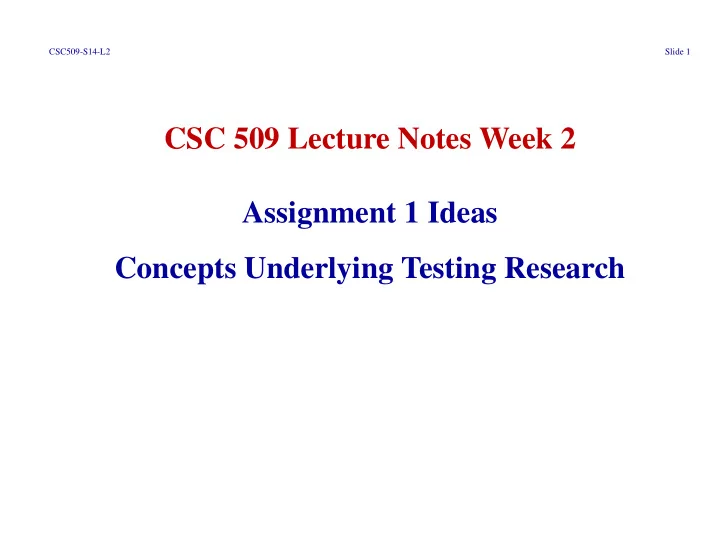

CSC509-S14-L2 Slide 1 CSC 509 Lecture Notes Week 2 Assignment 1 Ideas Concepts Underlying Testing Research
CSC509-S14-L2 Slide 2 I. As described in assignment 1 writeup, ev eryone briefly presents their selected paper.
CSC509-S14-L2 Slide 3 II. After the paper presentations, we’ll finish up testing terminology from Lecture Notes Week 1
CSC509-S14-L2 Slide 4 III. Some more specific testing terminology. A. Consider last five years of ISSTA pubs. B. There have been 140 papers over these years. C. Here are the top five keywords used:
CSC509-S14-L2 Slide 5 Top ISSTA Keywords, cont’d 1. [automated] test [case] generation (27 times) 2. static analysis (18 times) 3. symbolic execution (11 times) 4. dynamic analysis (10 times) 5. coverage (8 times)
CSC509-S14-L2 Slide 6 D. Majority of papers describe testing tools. 1. Many tools generate executable tests. 2. Others perform analysis before, during, after, or instead of tests.
CSC509-S14-L2 Slide 7 IV. So how does a testing tool do these things?
CSC509-S14-L2 Slide 8 IV. So how does a testing tool do these things? A. At the core is a program compiler .
CSC509-S14-L2 Slide 9 IV. So how does a testing tool do these things? A. At the core is a program compiler . B. It generates an annotated parse tree , or comparable structure.
CSC509-S14-L2 Slide 10 IV. So how does a testing tool do these things? A. At the core is a program compiler . B. It generates an annotated parse tree , or comparable structure. C. It also generates an symbol table .
CSC509-S14-L2 Slide 11 IV. So how does a testing tool do these things? A. At the core is a program compiler . B. It generates an annotated parse tree , or comparable structure. C. It also generates an symbol table . D. The generation, analysis, execution, or coverage procedure traverses the tree .
CSC509-S14-L2 Slide 12 IV. So how does a testing tool do these things? A. At the core is a program compiler . B. It generates an annotated parse tree , or comparable structure. C. It also generates an symbol table . D. The generation, analysis, execution, or coverage procedure traverses the tree . E. During the traversal, tool-specific rules are applied for the problem at hand.
CSC509-S14-L2 Slide 13 V. Consider the following example: public class Example { /** * Return true if the given integer is * positive and even. */ /*@ ensures \result == i > 0 && i % 2 == 0 @*/ public static boolean isPositiveEven(int i) { if (i > 0 && i % 2 == 0) return true; else return false; } }
CSC509-S14-L2 Slide 14 VI. (Symbolic) Execution A. Parse program code. B. At each node, apply execution rule. C. E.g., to evaluate ’>’ operator, do this:
CSC509-S14-L2 Slide 15 (Symbolic) Execution, cont’d public Value evalGreaterThan( TreeNode expr, SymbolTable symtab) { Value v1 = eval(expr.child1, symtab); Value v2 = eval(expr.child2, symtab); return new BooleanValue(v1.val > v2.val) }
CSC509-S14-L2 Slide 16 (Symbolic) Execution, cont’d D. Difference between regular and symbolic -- 1. For regular, lookup var value in symbol table. 2. For symbolic, use string var name, produce result with string concatenation. 3. E.g., to symbolically evaluate ’>’ operator:
CSC509-S14-L2 Slide 17 (Symbolic) Execution, cont’d public Value evalGreaterThan( TreeNode expr, SymbolTable symtab) { Value v1 = eval(expr.child1, symtab); Value v2 = eval(expr.child2, symtab); if (isLiteral(v1) && isLiteral(v2) return new BooleanValue(v1.val > v2.val) else return new StringValue( v1.val + ">" + v2.val); }
CSC509-S14-L2 Slide 18 VII. Blackbox Test Case Generation A. Apply well-known rules for test cases. B. E.g., five cases for a numeric range: 1. well below bound 2. 1 below bound 3. at bound 4. 1 above bound 5. well above bound
CSC509-S14-L2 Slide 19 Blackbox Test Case Generation, cont’d C. To implement, e.g. range tests 1. parse pre and post-conditions 2. traverse tree 3. for inequality of the form "x < C", eject test code like this for each rule-based value: x = nextRuleBasedValue(); assertTrue(validatePostcond(x,C));
CSC509-S14-L2 Slide 20 VIII. Whitebox Test Case Generation A. Apply similar well-know rules to blackbox. B. Parse code & traverse tree. C. Similar code ejection to blackbox.
CSC509-S14-L2 Slide 21 IX. Coverage A. Annotate program tree with line numbers. B. Execute tree. C. At each tree node with line number, increment it’s execution count annotation. D. Do post-execution analysis for coverage report.
CSC509-S14-L2 Slide 22 X. Static Analysis, e.g., for Smart Regression A. Trav erse changed portion of parse tree. B. Determine for each method in symbol table if it is reachable. C. If so, mark its tests as requiring re-execution.
CSC509-S14-L2 Slide 23 XI. Dynamic Analysis, E.g., Smart Regression A. Parse test code. B. For each called test method, memoize its results. C. If test method called again, use memoized value.
Recommend
More recommend